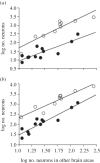Embodied cognitive evolution and the cerebellum
- PMID: 22734053
- PMCID: PMC3385677
- DOI: 10.1098/rstb.2012.0112
Embodied cognitive evolution and the cerebellum
Abstract
Much attention has focused on the dramatic expansion of the forebrain, particularly the neocortex, as the neural substrate of cognitive evolution. However, though relatively small, the cerebellum contains about four times more neurons than the neocortex. I show that commonly used comparative measures such as neocortex ratio underestimate the contribution of the cerebellum to brain evolution. Once differences in the scaling of connectivity in neocortex and cerebellum are accounted for, a marked and general pattern of correlated evolution of the two structures is apparent. One deviation from this general pattern is a relative expansion of the cerebellum in apes and other extractive foragers. The confluence of these comparative patterns, studies of ape foraging skills and social learning, and recent evidence on the cognitive neuroscience of the cerebellum, suggest an important role for the cerebellum in the evolution of the capacity for planning, execution and understanding of complex behavioural sequences--including tool use and language. There is no clear separation between sensory-motor and cognitive specializations underpinning such skills, undermining the notion of executive control as a distinct process. Instead, I argue that cognitive evolution is most effectively understood as the elaboration of specialized systems for embodied adaptive control.
Figures




References
-
- Harvey P. H., Krebs J. R. 1990. Comparing brains. Science 249, 140–146 10.1126/science.2196673 (doi:10.1126/science.2196673) - DOI - DOI - PubMed
-
- Shettleworth S. J. 1998. Cognition, evolution, and behavior. New York, NY: Oxford University Press
-
- Striedter G. F. 2005. Principles of brain evolution. Sunderland, MA: Sinauer.
-
- Dunbar R. I. M., Shultz S. 2007. Evolution in the social brain. Science 317, 1344–1347 10.1126/science.1145463 (doi:10.1126/science.1145463) - DOI - DOI - PubMed
-
- Sol D. 2009. Revisiting the cognitive buffer hypothesis for the evolution of large brains. Biol. Lett. 5, 130–133 10.1098/rsbl.2008.0621 (doi:10.1098/rsbl.2008.0621) - DOI - DOI - PMC - PubMed
MeSH terms
LinkOut - more resources
Full Text Sources
Research Materials
Miscellaneous
